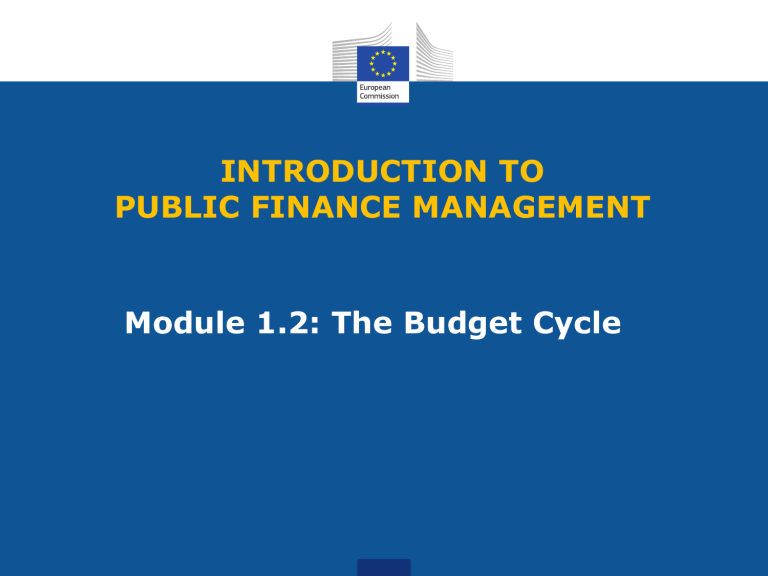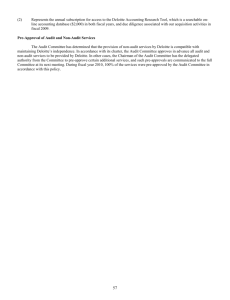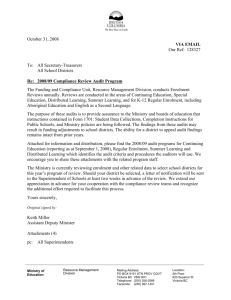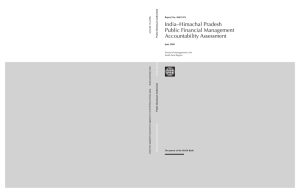The Budget Cycle INTRODUCTION TO PUBLIC

INTRODUCTION TO
PUBLIC FINANCE MANAGEMENT
Module 1.2: The Budget Cycle
Module Outline
The six phases of the Budget Cycle
The Six Phases of the Budget Cycle
Policy Review
Budget
Execution
Strategic
Planning
Budget
Preparation
External Audit
Accounting &
Reporting
3
Budget Cycle Exercise
• Match Tasks and Institutions in public finance the
six main Stages of the Budget Cycle – 30 mins
Phase 1. Strategic Planning
Conversion of economic and social policies into a medium-term programme of action, taking into account available resources
Macroeconomic policy National Development Plan
Medium-Term Fiscal Framework
Aggregate Budget and
Expenditure Ceilings
Sector strategies
Costing / fiscal impact assessments priorities within a fiscal constraint...
fiscal side planning side
Phase 2. Budget Preparation
Budget preparation is the process of converting strategic plans into public spending; the Budget preparation process must:
Be defined in the legislative framework: the Constitution, the
Organic Budget Law or PFM Act, financial regulations and administrative procedures;
Should integrate a medium term rolling process with the annual Budget;
Ultimately lead to the executive receiving “authority to spend” by the legislature in the Annual Budget Law – known as appropriations.
NB: Changes in the Budget Law require supplementary appropriations
Phase 2. Budget Preparation
Cabinet
Determine budgetary ceilings by sector/ministry
Send budget circular
Hearings
Submit to Parliament for Appropriation
Submit bid
7 Parliament
Phase 3. Budget Execution
Budget
Plan
Expenditure control
• Payroll
• Procurement of goods/services
• Transfers / subsidies
... and other...
Revenue collection
• Taxes (direct/indirect)
• Excises
• Duties
• Non-tax revenues
• Donor funding
Liquidity management
• Short term (cash management)
• Medium / long term (debt management)
Phase 3. Budget Execution
Authorisation by the Ministry of Finance or Line Ministry
Commitment to undertake future payment: contract
Verification of delivery to spending unit: liability
Payment Authorisation by MoF or Fin. Dept.
Cash Payment by Treasury or LM
Phase 4. Accounting & Reporting
Budgetary Accounting
Definition: maintaining records and reporting on the execution of the budget.
Aim: monitor and control compliance with budget appropriations.
Accounting basis (cash or accrual, same as the budgeting basis).
Phase 4. Accounting & Reporting
Financial Accounting
Definition: maintaining records and reporting on revenues and expenditure, assets and liabilities.
Aim: Annual Financial Statements;
• Revenues and expenditures;
• Balance sheet (assets and liabilities).
Accounting basis (cash or accrual, does not depend on the budgeting basis).
Phase 4. Accounting & Reporting
Coding Structure
Chart of Accounts (CoA): coding framework for financial transactions.
Aim: recording each financial transaction for purposes of expenditure control, costing, and economic and statistical analysis.
Phase 5. External Audit
Supreme Audit Institution (SAI):The institution of the State responsible for public external scrutiny of the government’s Annual Financial Statements l
“The principal task of SAIs is to examine whether public funds are spent economically, efficiently and effectively in compliance with existing rules and regulations.” INTOSAI (2009)
International standards require...
Independence from executive;
Legislative mandate enshrined in Constitution.
Phase
6. Policy Review
Assessment of actual versus desired government policy outcomes;
Ex-post analysis of impact of government policy programmes;
Is there a Performance Assessment Framework
(PAF) for monitoring and evaluation?
Adaptation of Strategic Planning on the basis of analysis of policy implementation.
NB: ... should be integrated with the Strategic
Planning Phase of the Budget Cycle
Key message...
Fiscal
Year:
Budget
T-1
Strat. Planning
& Budget Prep.
Budget Execution
Account. & Rep.
External Audit
Policy Review
Budget
T
Budget
T+1 t-2
Strat. Planning
& Budget Prep.
Budget Execution
Account. & Rep.
External Audit
Policy Review t-1
Strat. Planning
& Budget Prep.
Budget Execution
Account. & Rep.
External Audit
Policy Review t t+1 t+2










